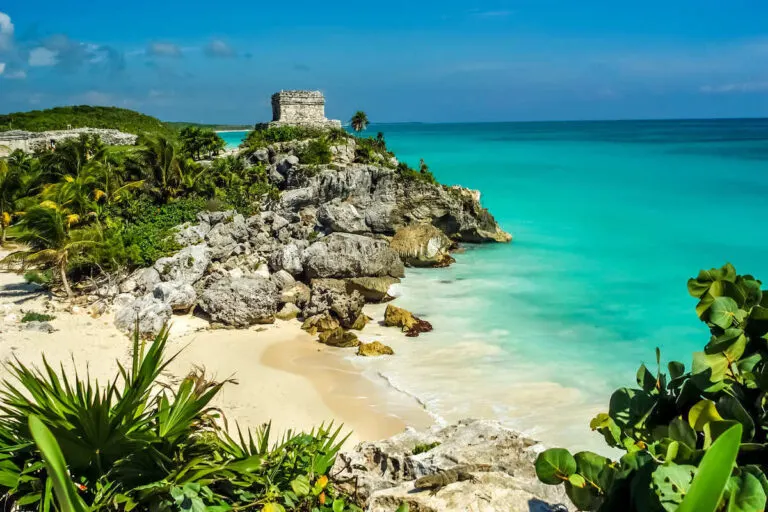For decades now, people have been flocking to sunny Mexico for some of that Old World flair.
While post-imperial gem Mexico City, charming colonial San Miguel de Allende, and a walled Merida get all the glory, Culture Buffs often ignore Tulum.
Yes, it is part of the Riviera Maya, and yes, it is best known as a resort and leisure destination, home to a plethora of five-star resorts and entertainment venues.
However, it does have a lot to offer in addition to award-winning luxury stays and pristine beaches.
In fact, Tulum may well be the top cultural destination in Mexico this year and this is why:
Why Is Tulum Still Massively Underrated As A Cultural Spot?
Tulum is already one of the most popular tourist spots in the Mayan Riviera, largely due to its tropical coastline.
This attracts the usual beach bum type whose sole interest is relaxing on the thin white sands while getting their feet licked by the warm waters.
All-inclusive stays are part of its appeal to foreigners, with household names like Conrad Tulum Riviera Maya and Secrets Tulum Resort & Spa hosting Americans year-round and being known for catering to their every need while on vacation.

Still, little is said about Tulum’s cultural side other than the odd footnote on the archaeological zone in broader articles about Playa Paraiso or the town’s lively nightlife, even though it is a local center for the arts and a hugely important Mayan settlement.
It is distinguished for being one of the oldest cities built by the Mayans, at the close of their civilization, only two centuries ahead of the European colonizers’ arrival.
More specifically, some of the oldest structures in Tulum date back to the 13th and 15th centuries.

That’s still over 800 years ago, but in the grand scheme of things, the settlement is relatively young in character when taking into account other far more ancient Mayan citadels like Chichen Itza and Palenque, dating back between 1,500 and 1,800 years.
Why Is Tulum So Unique?
As Tulum is so ‘young’, however, it offers us a precious insight into life in a Mayan city before their society collapsed, as well as their resistance, seeing that they remained in the area for at least 70 years after the Spanish made their initial incursions.

The ruins look in better shape, as well, as Tulum was abandoned much later.
The most striking landmarks in the archaeological site include the Temple of the Frescoes, previously used to track the movements of the sun, the pyramidal El Castillo, and the Temple of the Descending God.
This winged deity was a common source of inspiration for stucco work and sculptures in Tulum, commonly found around surviving structures.
However, its origins and details as to how exactly its associated cult operated remain a mystery.

All the more exciting.
Of course, Tulum is also where you’ll find the most iconic postcard view in the Mexican Caribbean: that of an ancient temple resting on a cliff facing the turquoise Caribbean, with a staircase leading down to a paradisaical swimming spot aptly titled ‘Ruins Beach’.
What To See Beyond The Tulum Ruins
Though it is the number one tourist attraction in town, Tulum’s cultural wonders are not restricted to the archaeological zone: prior to being a resort zone, the municipality itself was a thriving Mayan fishing village, and it retains part of that native charm outside the Zona Hotelera.

The lively streets of Centro are lined by traditional Mexican restaurants and souvenir shops, while the up-and-coming residential district of La Veleta is located near crystal-clear cenotes and verdant reserves, providing visitors an escape from the overdeveloped beachfront.
Speaking of cenotes, these are natural sinkholes the Mayans considered sacred and where some sacrificial ceremonies were carried out.
Fortunately, visitors to Cenote Cristal or Cenote Escondido, two of Tulum’s most famous, are no longer served on a platter for the Mexican Gods to feast on.

Both are open to the general public and accessible for swimming.
Wooden steps lead down to the cenotes, diving platforms for adventurous jumpers, toilets, and other tourist-friendly facilities are available in the vicinity.
The neighboring Sian Ka’an Biosphere Reserve, a UNESCO World Heritage Site comprising 2,039 square miles, and including a section of the Yucatanese coral reef, and over 20 other archaeological sites, is sometimes included as a Tulum attraction due to their proximity.
Tulum Now Has Its Own International Airport

Furthermore, Tulum is now the only cultural Mayan town on the Riviera to have its own international airport, since the Felipe Carrillo Puerto Airport opened last December, hosting flights from a number of U.S. cities and, soon enough, Europe.
The promised launch of the Maya Train from Cancun to Tulum will lead to a further increase in bookings for this cultural spot, too, as it has already recorded a significant growth of 23% in the number of visitors year-on-year, surpassing the historical Chichen Itza by 6 percentage points.
If you’re planning on visiting Tulum or any Riviera Maya spot this spring and you haven’t booked accommodation yet, we suggest you act fast: due to its trendiness, the entire region is on the brink of selling out this upcoming season.
Credit: Source link

